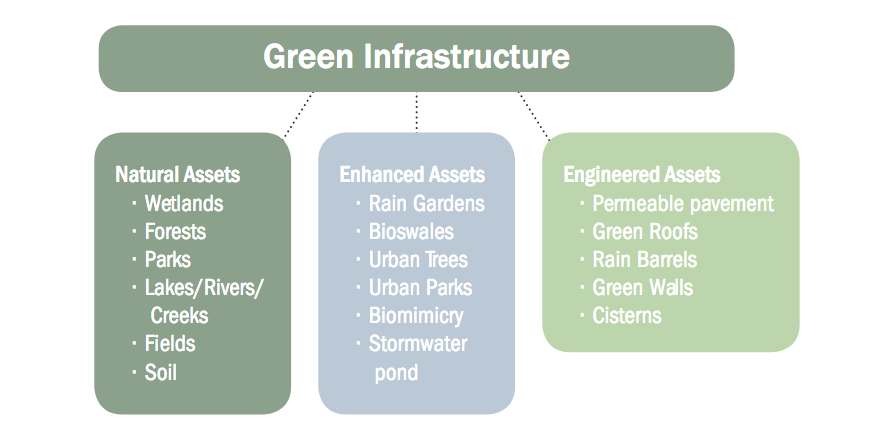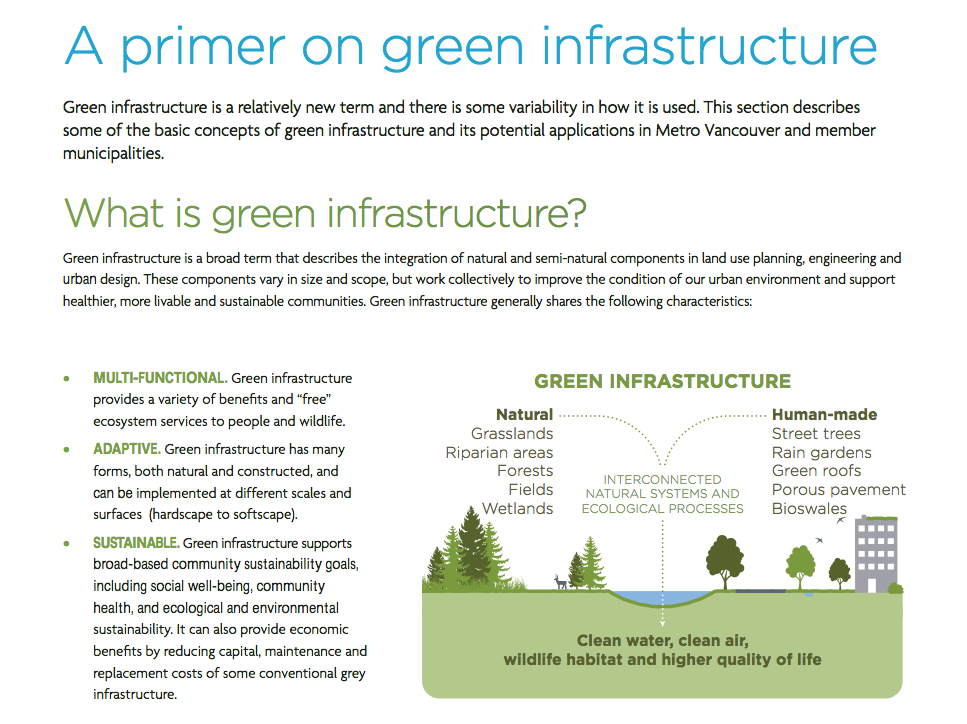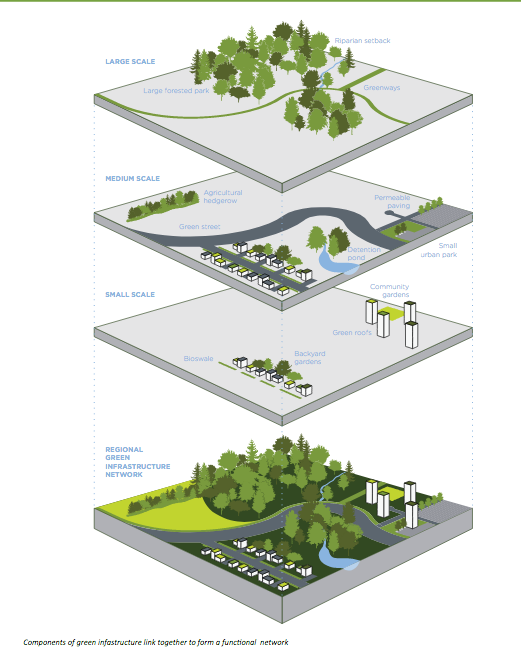Learning Objectives
- Examine the terminology used to describe green infrastructure systems,
- Discuss what role green infrastructure has in addressing urban challenges.
Introduction
Welcome to the first module of the Green Infrastructure course. It makes sense to begin first by introducing yourself to other members of the class – as you will find this network of professionals to be a very rich resource for your continued learning journey.
We are excited to begin this learning experience by clarifying some basic definitions for Green infrastructure (GI) and explore the fundamentals of GI. We begin with the assumption that urban centres face three main challenges with regard to water management: storm flooding, water pollution and water shortages. Urban areas around the world are working to reduce runoff and pollution, and also to restore downstream ecologies. This occurs when low impact development methods are integrated with grey infrastructures, large-scale flood control projects and ecological rehabilitation. There are some promising experiments taking place worldwide with Green Infrastructure systems to support these efforts.
Green infrastructure is a broad category that includes both natural ecosystems and engineered systems created to mimic the natural functions and services provided by healthy ecosystems to human communities. Green infrastructure is referred to using various terms including natural asset infrastructure, low-impact development, green rainwater infrastructure, blue-green infrastructure, etc. Each term has been developed to describe a system focused on distinct outcomes and often on a particular scale. When you read the article by Fletcher, it will give you a sense of how these terms are used and how they have evolved over time. For the purposes of this course, we will focus primarily on enhanced and engineered green assets, particularly as they relate to water.
Source: https://mnai.ca/media/2019/07/SP_MNAI_Report-1-_June2019-2.pdf
GI is considered a strategy for mitigating the harmful impacts of urban stormwater runoff and has been implemented in cities around the world. Also referred to as Green Rainwater Infrastructure (GRI) or Low-Impact Development (LID), these systems have the capacity to capture, infiltrate, treat, and convey urban runoff safely into the natural environment to avoid pollution, flooding, and many other unintended consequences. GI systems have been found to eliminate over 90% of pollutants that were commonly found in roadway runoff by way of infiltrating runoff through soils and plant tissues. In addition to natural GI, enhanced and engineered GI systems – often in the form of green roofs, bioretention cells, and permeable pavements – are capable of retaining 50-70% of annual stormwater runoff when maintained properly. This graphic provides a big picture primer.
Source: Page 6 of http://www.metrovancouver.org/services/regional-planning/PlanningPublications/ConnectintheDots.pdf
Broadly speaking, green infrastructure (GI) encompasses any system that uses ecosystem functions to provide a service to human societies. GI systems vary significantly in their purpose, capacity, and complexity – however, all are assets that require ongoing strategic asset management. While green infrastructure is anything that uses biological systems and ecosystem functions to provide a service to humanity, effective green infrastructure does so without degrading those systems or functions. Here are some of the systems we will talk about in this course and what they are designed to do:
Green Infrastructure and Catchment Scale Effects
Source: Table 1. Summary of Common Low-Impact Development (LID) Practices by Heather E. Golden and Nahal Hoghooghi is licensed under a CC BY NC license.
Conventional (or grey) infrastructure benefits from decades of precedent and well-established, straightforward design guidance to help engineers meet quantifiable outcomes: load-bearing capacity, sewer discharge rates, reservoir storage, etc. While assessing the performance of conventional infrastructure is an established practice, methods for assessing all of GI’s benefits are only beginning to be understood, developed, and distributed. Measuring the performance of the GI is significantly more complex because it aspires to provide more for urban spaces than conventional grey infrastructure. Ecological and societal benefits are more difficult to quantify than the conveyance capacity of a pipe. The ecosystem services supported by GI operate on a variety of scales and can serve multiple functions: water quality improvements, enhanced water security, pollination, enhanced food security, health and wellness improvements, enhanced livability, and urban biodiversity. This diverse array of benefits provides GI with a compelling cost-benefit analysis.
Scales of GI
Source: Page 8 of http://www.metrovancouver.org/services/regional-planning/PlanningPublications/ConnectintheDots.pdf
As you will explore in upcoming modules, urban drainage and the integration of grey with blue-green cities through the implementation of GI is not only providing co-benefits such as supporting the management of stormwater, reducing the heat island effect, improving water quality, enhancing water security, and providing benefits to health and wellness, it is also contributing to climate change resilience.
Learning Activities
- Read the four short articles and view the video for this module.
Discussion Question
- Introduce yourself and share your learning goals for the course.
Readings & Resources
Readings
- EPA Green Infrastructure Guide
- Fletcher, T. D., Shuster, W., Hunt, W. F., Ashley, R., Butler, D., Arthur, S., Trowsdale, S., Barraud, S., Semadeni-Davies, A., Bertrand-Krajewski, J.-L., Mikkelsen, P. S., Rivard, G., Uhl, M., Dagenais, D., & Viklander, M. (2014). SUDS, LID, BMPs, WSUD and more – The evolution and application of terminology surrounding urban drainage. Urban Water Journal, 12(7), 525–542. https://doi.org/10.1080/1573062x.2014.916314
- Blue and Green Cities: Blue-Green Infrastructure in Managing Urban Water Resources (pg. 43-57)
Videos
Additional Resources and Citations
- Bartesaghi Koc, C., Osmond, P., & Peters, A. (2017). Towards a comprehensive green infrastructure typology: A systematic review of approaches, methods and typologies. Urban Ecosystems, 20(1), 15–35. https://doi.org/10.1007/s11252-016-0578-5
- Young, R., Zanders, J., Lieberknecht, K., & Fassman-Beck, E. (2014). A comprehensive typology for mainstreaming urban green infrastructure. Journal of Hydrology, 519, 2571–2583. https://doi.org/10.1016/j.jhydrol.2014.05.048





 (Note: this book is copyrighted).
(Note: this book is copyrighted). 